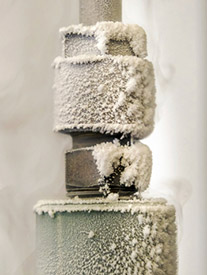Cold Weather Is Coming; How Should I Prepare My Pumps?
 Winter is a harsh reality for many GIW customers, so our experts have some helpful tips to keep your pumps running smoothly, even in extreme cold.
Winter is a harsh reality for many GIW customers, so our experts have some helpful tips to keep your pumps running smoothly, even in extreme cold.
The preferred environment for a pump is in a heated shelter that protects the equipment from the elements. If a heated shelter is not feasible, it’s important to take steps to avoid three conditions: thermal shock, drainage freeze, and stuffing box drain freeze.
- Thermal shock — When the warm liquids of a process contact the cold components of the pump, thermal shock can occur, and the wear components can fracture. To avoid severe damage, it is necessary to bring the pump components, particularly the wear components that come into contact with the warmer liquid (impeller, shell, suction liner), up to temperature gradually, either with process flow or with external heat.
- Drainage — When a pump is shut down, some liquid can remain in the bottom. When a pump is shut down in below-zero conditions, it is critical to drain any excess liquid out of the pump to prevent freezing. The frozen liquid can expand and break pump or drain components. The easiest way to ensure your pump drains completely is to install it with the drainage valve on the bottom.
- Stuffing box — The stuffing box seals the area where the shaft goes through the back of the pump. During normal operation, liquid drips from the stuffing box; this drip generally doesn’t cause any problem. However, if this water freezes, the ice can build up around the shaft and the bearing housing. Operators must make sure that the stuffing box and the drain lines are heated to avoid freezing and backup at any point in the line.
In extremely cold conditions, any condensation or moisture inside the bearing housing or the motor can turn to ice when the pump is not in operation. The ice can then damage the bearings or motor when the pump is started up again.
Cold weather can also be an issue with maintenance. Gaskets and o-rings will not be flexible, and may not seal properly when installed. Parts with tight tolerances such as shaft sleeves or casing-to-pedestal fits may not go together.
The easiest way to avoid all of these issues during the winter is to install the pump components inside a heated pump house.
[cta]Do you have questions about the industry, our company or our products and services? Email your comments and questions to paaron@giwindustries.com.To learn more about GIW, call 1.888.TECHGIW (832-4449) or visit GIW® Minerals Pumps.[/cta]

